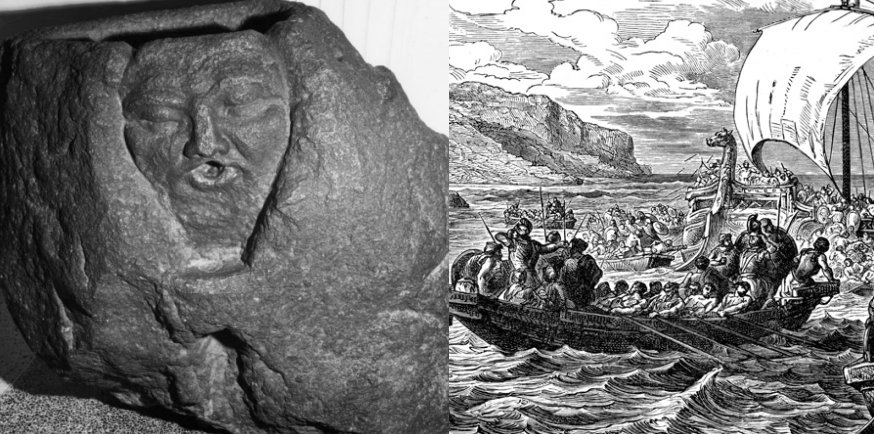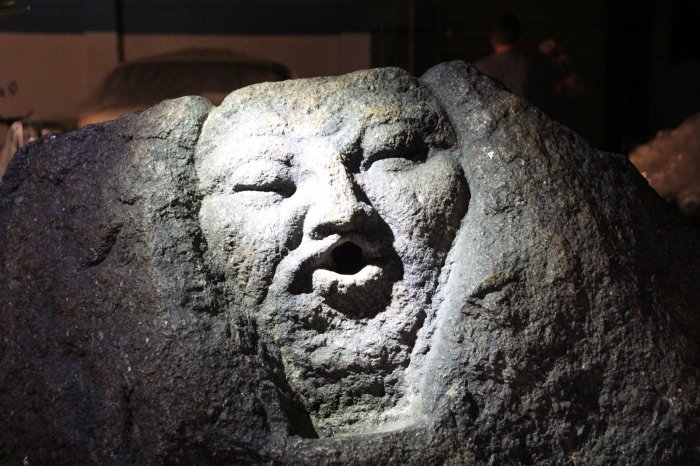Ancient Mysteries Of Chicago: Is The Puzzling Waubansee Stone A Neglected Pre-Columbian Artifact?
Ellen Lloyd - AncientPages.com - One of the most mysterious artifacts we encounter in North America is the puzzling Waubansee Stone.
The three-foot-high, 3,000-pound boulder of granite has a human face carved on one end. How old is the Waubansee Stone and who carved it?
Some think the Waubansee Stone was made by an advanced ancient civilization that was present in North America long before Columbus. Others think a soldier carved the face in honor of the Potawatomi Indians. There are also those who think the face on the Waubansee Stone is just a natural formation.
Contradicting Stories About The Waubansee Stone
There are many different stories handed down about the stone's past. The stone is on permanent display at the Chicago Historical Society, where it once served as a drinking fountain.
According to the official version, the four-inch-deep basin was used by Native Americans for grinding grain. In the early 1800s, a soldier stationed at Fort Dearborn chiseled the face in the likeness of friendly Potawatomi chief Waubansee.
However, nothing more was heard about the stone until it a prominent Chicago family put it on display in their front yard in the 1860s. The family gave the stone to the museum in 1914.
Image credit: Scott Walters
The Chicago Museum cut the stone and used it as a drinking fountain for 18 years.
The two holes on either side of the Waubansee Stone have also intrigued many researchers. Were the holes bored?
In the 1881 book, Chicago Antiquities by Henry H. Hurlbut, a member of the Chicago and Wisconsin historical societies admitted it’s unknown how the holes were created and because there is no information that could cast more light on the mystery. “Its prehistoric record, of course, is not very clear to us,” Hurlbut wrote.
Could This Be The Stone Of Sacrifice And Death?
Some historians have speculated that the face was carved on the rock long before the arrival of explorers and settlers, even the Potawatomi.
In The Story of Chicago (1892), Joseph Kirkland writes: "Many persons have looked on it as a relic of prehistoric art--the sacrificial stone of an Aztec teocalli perhaps."
If the boulder was the Stone of Death and Sacrifice, it means that the face depicts a god or a spirit to whom indigenous Americans like the Mound Builders, or perhaps ancient overseas voyagers, offered their victims.
However, this doesn’t explain how the Waubansee Stone ended up in Chicago.
Was The Waubansee Stone Created By The Phoenicians?
Frank Joseph, an alternative history researcher and author of several books thinks the stone was made by the Phoenicians, a Semitic people closely related to the Hebrews. The Phoenicians called themselves Canaanites, and modern researchers believe they were the descendants of two groups, the early Canaanites, who inhabited the coast of present-day Lebanon, and seafarers.
The Phoenicians established several colonies throughout the Mediterranean. including Carthage, their greatest city, in North Africa that became a dominant power in the Western Mediterranean.
Mainstream historians have rejected the possibility that the Phoenicians visited North America before Columbus' arrival. Some alternative history researchers such as Dr. Barry Fell (1917-1994), who became famous for his controversial work in New World epigraphy, argued that various inscriptions in the Americas are best explained by extensive pre-Columbian contact with Old World civilizations.
Some alternative ancient history researchers have suggested the Waubansee Stone was created by the Phoenicians.
In one of his books, America B.C.: Ancient Settlers in the New World, Dr. Fell offers many examples of Old World civilizations left behind symbols and messages all over America.
According to Frank Joseph, there are parallels between the Waubansee Stone and other artifacts. "One thing, the Carthaginians sculpted disembodied faces face-on. The other thing, they sculpted people with closed eyes," which signified death. They also wore chin beards, he notes.
Druids in Vermont? Phoenicians in Iowa? These are just a few of the interesting bits of information contained in this volume of American pre-history. This groundbreaking work shatters many of the myths of America centuries ago. Read more
Frank Joseph also rejects the idea the Waubansee Stone was a corn mortar. It points to a tophet," he says, naming the outdoor stone altars upon which Carthaginians were known to sacrifice children to appease the gods.
Why Hasn’t The Museum Examined The Waubansee Stone?
Ascertaining the legitimacy of a historic object is by no means easy. There are many reasons why experts prefer not to examine an artifact. Some objects kept at a museum can be fakes, but is it really up to the visitors to decide what is real and not?
"We give them the options of deciding if the artifacts are real, fake or maybe. The 'maybe' answer isn't a cop-out on our part. Some objects you just can't tell if they are real or not. There might be physical tests we could do on the object to help us find the truth, but in many cases, the objects are so rare and delicate, it is not worth damaging them to find out," curator Peter Alter said.
Journalist Jeff Huebner who writes for the Chicago Reader investigated the controversial history of the Waubansee Stone.
“Has the Chicago Historical Society ever had the Waubansee Stone examined by geologists, archaeologists, metallurgists, or art historians?” Huebner asks.
Is the Puzzling Waubansee Stone a precious, neglected Pre-Columbian artifact? Image credit: Office of the Cultural Historian of the City of Chicago
In an interview with Ralph Pugh, a 19-year society historian Huebner was told the museum never bothered to examine the boulder.
“You know, I can reveal that in terms of analysis of the stone and other clues, we can say we haven't looked into those claims." Pugh thinks the alternative theories "seem fanciful," rooted in how 19th-century Chicagoans yearned to view their young, fast-growing city as having an antiquated and folkloric past. "The stone caught a lot of people's imaginations, and that accounts for a lot of the overimagination."
Yet he admits, "Science could help us discount some speculations."
So, what should we think of the puzzling Waubansee Stone?
Is it a piece of prehistoric art, was it made in modern times or is it the work of Mother Nature? Without proper examination, it’s impossible to determine who carved the face on the rock.
If the Waubansee Stone was really made by an Old World civilization, the rock could easily re-write the history of North America.
Needless to say that the Waubansee Stone is one of many mysterious ancient rocks and stones discovered in North America.
Written by Ellen Lloyd - AncientPages.com
Copyright © AncientPages.com All rights reserved. This material may not be published, broadcast, rewritten or redistributed in whole or part without the express written permission of AncientPages.com
Expand for referencesMore From Ancient Pages
-
 Prehistoric Quarry, Stelida, Naxos: Early Human Moved Through Mediterranean Much Earlier
Archaeology | Oct 17, 2019
Prehistoric Quarry, Stelida, Naxos: Early Human Moved Through Mediterranean Much Earlier
Archaeology | Oct 17, 2019 -
 Asgard Walls Built By Giant Master Mason And Birth Of Magical Horse Sleipnir
Featured Stories | Apr 19, 2018
Asgard Walls Built By Giant Master Mason And Birth Of Magical Horse Sleipnir
Featured Stories | Apr 19, 2018 -
 Colossus Of Standing Falcon-Headed God Horus Unearthed In Egypt’s Luxor
Archaeology | Jan 6, 2020
Colossus Of Standing Falcon-Headed God Horus Unearthed In Egypt’s Luxor
Archaeology | Jan 6, 2020 -
 Mayong – Mysterious Ancient Land Of Black Magic In India
Featured Stories | Mar 7, 2019
Mayong – Mysterious Ancient Land Of Black Magic In India
Featured Stories | Mar 7, 2019 -
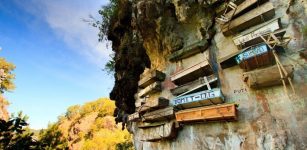 ‘Aerial Cemetery’ – Ancient Tradition Of ‘Hanging Coffins’
Ancient Traditions And Customs | Sep 9, 2018
‘Aerial Cemetery’ – Ancient Tradition Of ‘Hanging Coffins’
Ancient Traditions And Customs | Sep 9, 2018 -
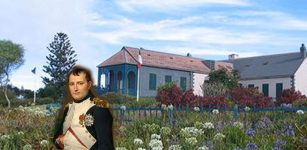 On This Day In History: Napoleon Bonaparte Dies In Exile – On May 5, 1821
News | May 5, 2016
On This Day In History: Napoleon Bonaparte Dies In Exile – On May 5, 1821
News | May 5, 2016 -
 Easter Island’s Statues Reveal Bodies Covered With Unknown Ancient Petroglyphs
Archaeology | Jan 21, 2014
Easter Island’s Statues Reveal Bodies Covered With Unknown Ancient Petroglyphs
Archaeology | Jan 21, 2014 -
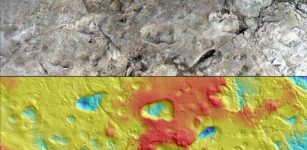 Mysterious Footprints In Tanzania Made By Early Humans Not Bears
Archaeology | Dec 1, 2021
Mysterious Footprints In Tanzania Made By Early Humans Not Bears
Archaeology | Dec 1, 2021 -
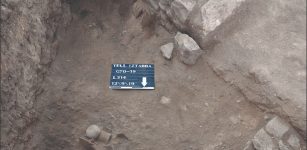 Ancient Town’s Destruction Dated With Help Of Chicken Bones And Snail Shells
Archaeology | Aug 17, 2022
Ancient Town’s Destruction Dated With Help Of Chicken Bones And Snail Shells
Archaeology | Aug 17, 2022 -
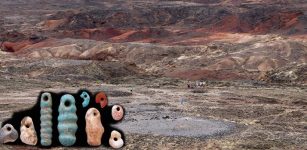 Surprising Discovery: Massive Cemetery Built 5,000 Years Ago Near Lake Turkana, Kenya
Archaeology | Aug 24, 2018
Surprising Discovery: Massive Cemetery Built 5,000 Years Ago Near Lake Turkana, Kenya
Archaeology | Aug 24, 2018 -
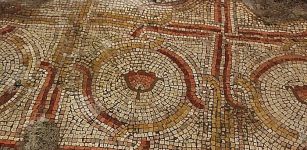 Ancient Mosaic Floor Decorated With Colorful Floral Designs Re-Uncovered After 40 Years
Archaeology | Mar 25, 2023
Ancient Mosaic Floor Decorated With Colorful Floral Designs Re-Uncovered After 40 Years
Archaeology | Mar 25, 2023 -
 Rare Magic Mirror In Cincinnati Museum Has A Secret Hiding In Plain Sight
Artifacts | Jul 19, 2022
Rare Magic Mirror In Cincinnati Museum Has A Secret Hiding In Plain Sight
Artifacts | Jul 19, 2022 -
 How Greenland Got The ‘Wrong’ Name Thanks To Viking Erik The Red
Ancient History Facts | Mar 21, 2017
How Greenland Got The ‘Wrong’ Name Thanks To Viking Erik The Red
Ancient History Facts | Mar 21, 2017 -
 Cleveland’s Prehistoric Sea Monster Had A Mouth Twice As Large As A Great White Shark
Fossils | Mar 3, 2023
Cleveland’s Prehistoric Sea Monster Had A Mouth Twice As Large As A Great White Shark
Fossils | Mar 3, 2023 -
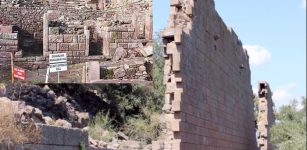 Headteacher’s Sarcophagus Unearthed In Ancient City Of Aigai, Turkey
Archaeology | Jan 25, 2017
Headteacher’s Sarcophagus Unearthed In Ancient City Of Aigai, Turkey
Archaeology | Jan 25, 2017 -
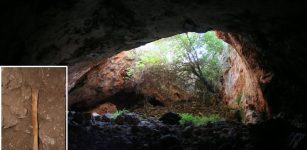 Ancient Human Remains Buried In Spanish Caves Were Subsequently Manipulated And Utilized
Archaeology | Sep 21, 2023
Ancient Human Remains Buried In Spanish Caves Were Subsequently Manipulated And Utilized
Archaeology | Sep 21, 2023 -
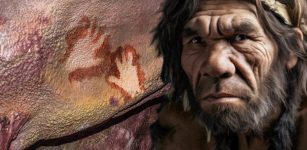 World’s Oldest Hand Stencils Were Made By Neanderthals In The Maltravieso Cave 66,000 Years Ago
Archaeology | Dec 9, 2024
World’s Oldest Hand Stencils Were Made By Neanderthals In The Maltravieso Cave 66,000 Years Ago
Archaeology | Dec 9, 2024 -
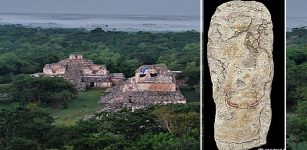 A Painted Vault Lid Discovered In Royal Palace Of Ek’ Balam Will Shed Light On History Of The Acropolis Of Ek’
Archaeology | Sep 16, 2023
A Painted Vault Lid Discovered In Royal Palace Of Ek’ Balam Will Shed Light On History Of The Acropolis Of Ek’
Archaeology | Sep 16, 2023 -
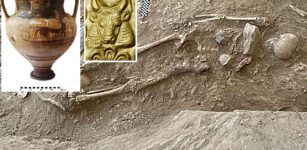 Tombs Rich In Artifacts Discovered By Swedish Expedition In Cyprus
Archaeology | Jul 6, 2023
Tombs Rich In Artifacts Discovered By Swedish Expedition In Cyprus
Archaeology | Jul 6, 2023 -
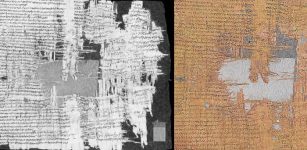 Newly Discovered Papyrus Reveals An Intriguing And Gripping Criminal Case From The Roman Empire
Archaeology | Jan 29, 2025
Newly Discovered Papyrus Reveals An Intriguing And Gripping Criminal Case From The Roman Empire
Archaeology | Jan 29, 2025

